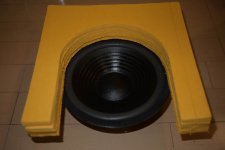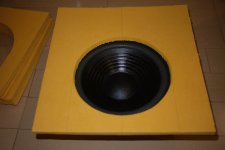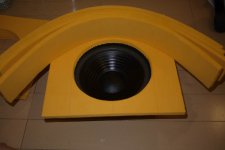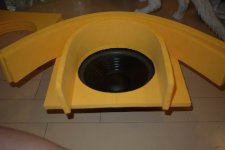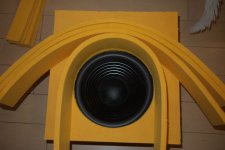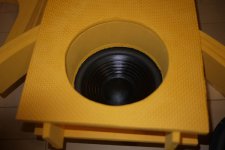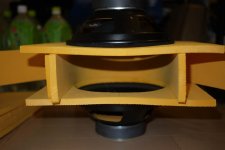I'm currently building some OBs with the complete opposite purpose to most in this thread. I listen from far away, and with speakers way higher than is best.
However, I can't help thinking my solution would work just as well near-field.
I'm using the Seas Excel C18 coax on a 30cm wide baffle. I cross to an OB woofer below 300hz.
However, if I were listening nearfield at sane levels rather than 5 metres away in a huge room, i might be able to get away with just the C18 down to sub level.
My in-room measurements (and listening) from 10cm nearfield all the way out to the 5m listening position show remarkable consistency for distance and horizontal/vertical dispersion.
On the downside, they aren't cheap.
However, I can't help thinking my solution would work just as well near-field.
I'm using the Seas Excel C18 coax on a 30cm wide baffle. I cross to an OB woofer below 300hz.
However, if I were listening nearfield at sane levels rather than 5 metres away in a huge room, i might be able to get away with just the C18 down to sub level.
My in-room measurements (and listening) from 10cm nearfield all the way out to the 5m listening position show remarkable consistency for distance and horizontal/vertical dispersion.
On the downside, they aren't cheap.
You might want to consider having 4 bolts or threaded rods holding the two drivers together in relative alignment. There is a lot force between them which then cancels. But EVA alone may flex too much. Looking forward to seeing the EVA SLOB though.
LOL that is almost exactly how I am designing it
I am creating a curved form of 4 pieces of 70mm wide by about 700mm long strips which will be laminated into the slot form. covered with another 300mm x 300mm sheet on each side to separate the remain parts of the inside/outside of the slot, and then drivers are then rear mounted onto either side of this slot form. The diameter of the curve of the slot form is the size of the rubber surround so that the driver frame is full supported by 90mm (70mm + 10mm + 10MM) of solid EVA over 180deg of its frame. I can then run threaded bolts through this 90mm thick EVA and compress the drivers into EVA into one solid form.
The EVA will then also act as a solid damping for any vibrations, but the drivers will be in opposite polarity, so in force canceling mode so there should be minimal vibrations to start with.
I will post some pictures of my cut EVA when I get home from work.
Last edited:
I'm currently building some OBs with the complete opposite purpose to most in this thread. I listen from far away, and with speakers way higher than is best.
However, I can't help thinking my solution would work just as well near-field.
I'm using the Seas Excel C18 coax on a 30cm wide baffle. I cross to an OB woofer below 300hz.
However, if I were listening nearfield at sane levels rather than 5 metres away in a huge room, i might be able to get away with just the C18 down to sub level.
My in-room measurements (and listening) from 10cm nearfield all the way out to the 5m listening position show remarkable consistency for distance and horizontal/vertical dispersion.
On the downside, they aren't cheap.
What a cool driver - never knew Seas made such a cool 5in coax before. Yikes that is pricey.
Here is a poor man's DIY version I was playing with:
http://www.diyaudio.com/forums/full-range/279043-daytonator-pa130-8x-3.html
I need to find a small tweeter I can stick into the pole piece bore. Someone suggested a 20mm Tang Band designed just for that sort of thing. Then it can be smoothly integrated with cone as a waveguide and not have baffle diffraction from edge of tweeter.
xrk, another tweeter you could consider for your diy coaxial is the peerless OX20
https://www.madisoundspeakerstore.c...erless-ox20sc00-04-19mm-textile-dome-tweeter/
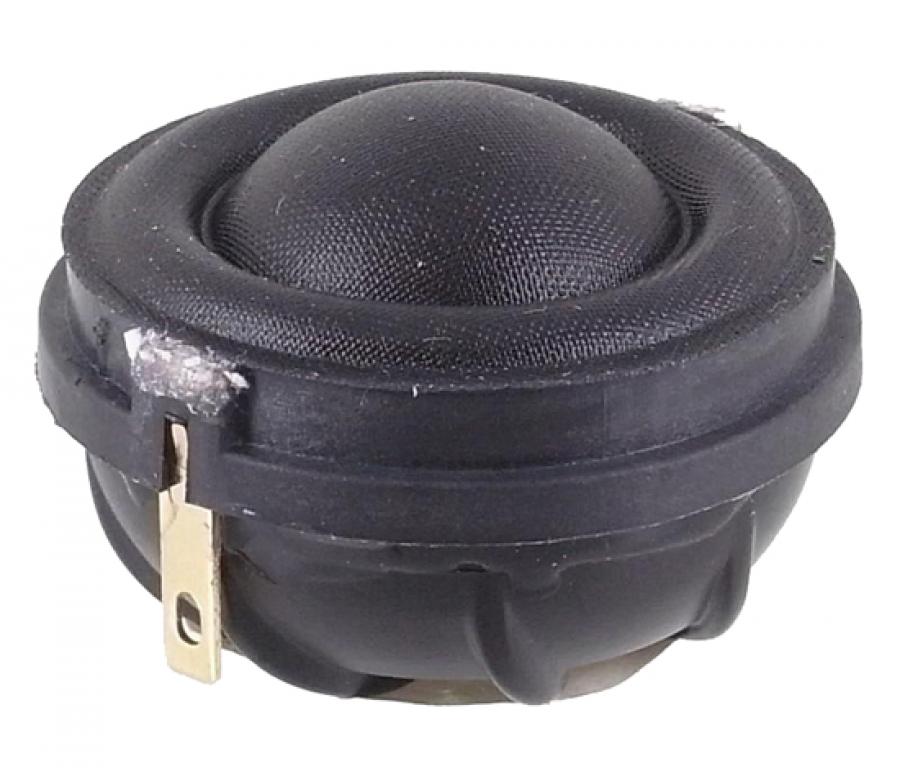
I also wonder if this might work well in this OB design with a small waveguide
https://www.madisoundspeakerstore.c...erless-ox20sc00-04-19mm-textile-dome-tweeter/

I also wonder if this might work well in this OB design with a small waveguide
OK here are some pictures of the EVA foam I have cut for the slot-loaded open baffle. This is the slot apparatus and the drivers are GRS 8PF-8
I started by following the nelson pass original design which cuts a curved slot shape into multiple layers of material (in his case MDF, in mine EVA) and laminate them to create the compression channel. But when I started building this way, I realized that it 1) wasted a lot of material that had to be cut away and 2) it created a very rough interior surface that would need to be sanded smooth. Since this channel is compressing the sound/air, I am thinking that the inner surface should be smooth to create as little turbulence as possible.
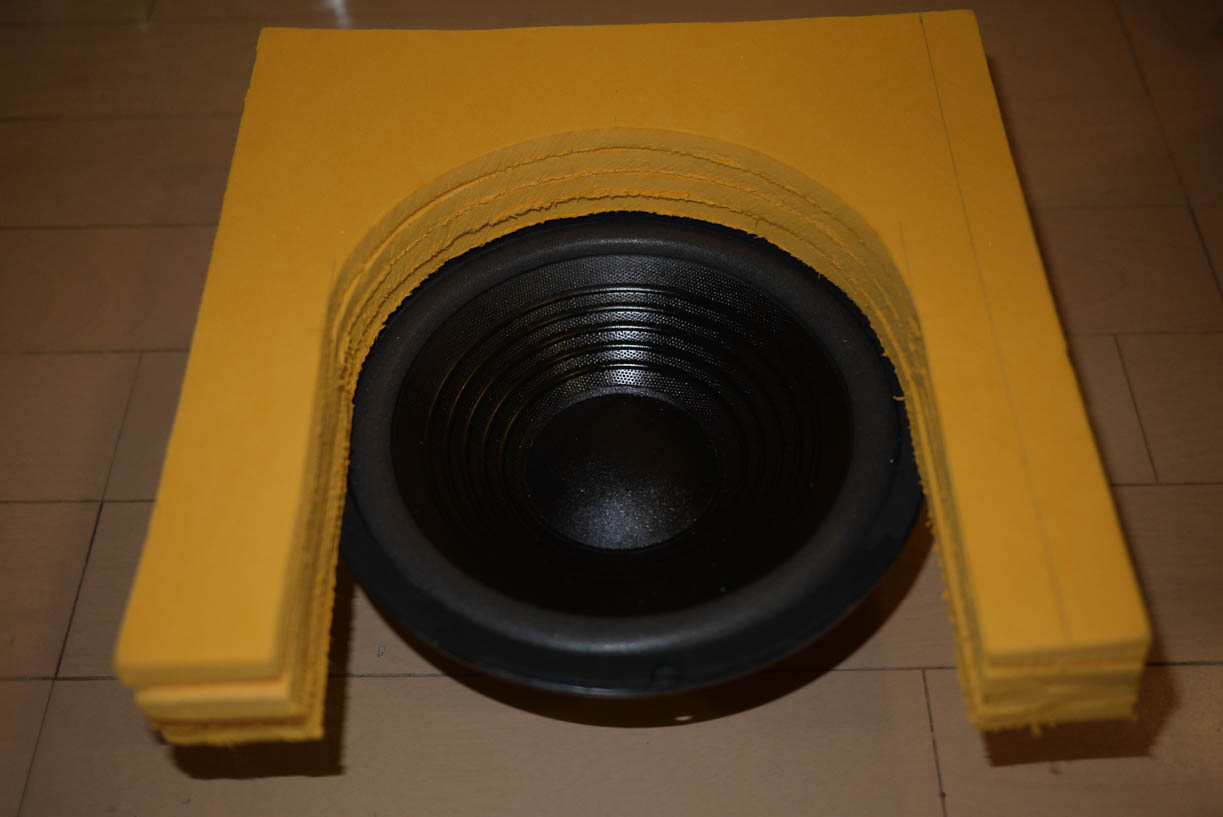
I then realized that I could take advantage of the ability of EVA to curve very easily. So I cut 4 strips, 70mm wide (my slot channel width) with the plan to laminate them to create a solid structure. I might be able to get away for 2x layers, but I plan to make 4x layers to make it very solid. Combine with panels top and bottom and then rear mounting the driver with threaded bolts going through the 90mm of solid EVA. For these pictures I pinned the inner strip to the rectangular piece. I may laminate another layer on each side, around the frame of the driver to give those rectangular pieces more rigidity, especially in the front which will be bolted up to the driver.
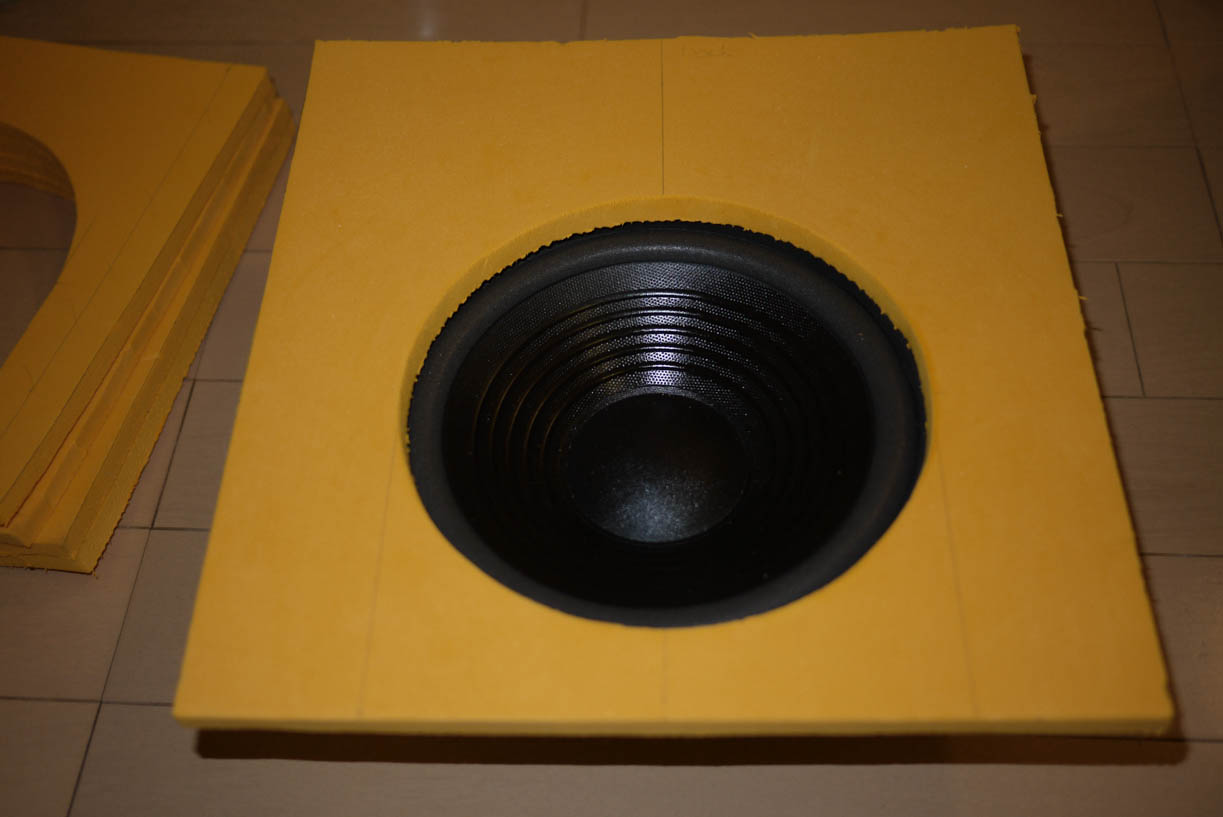
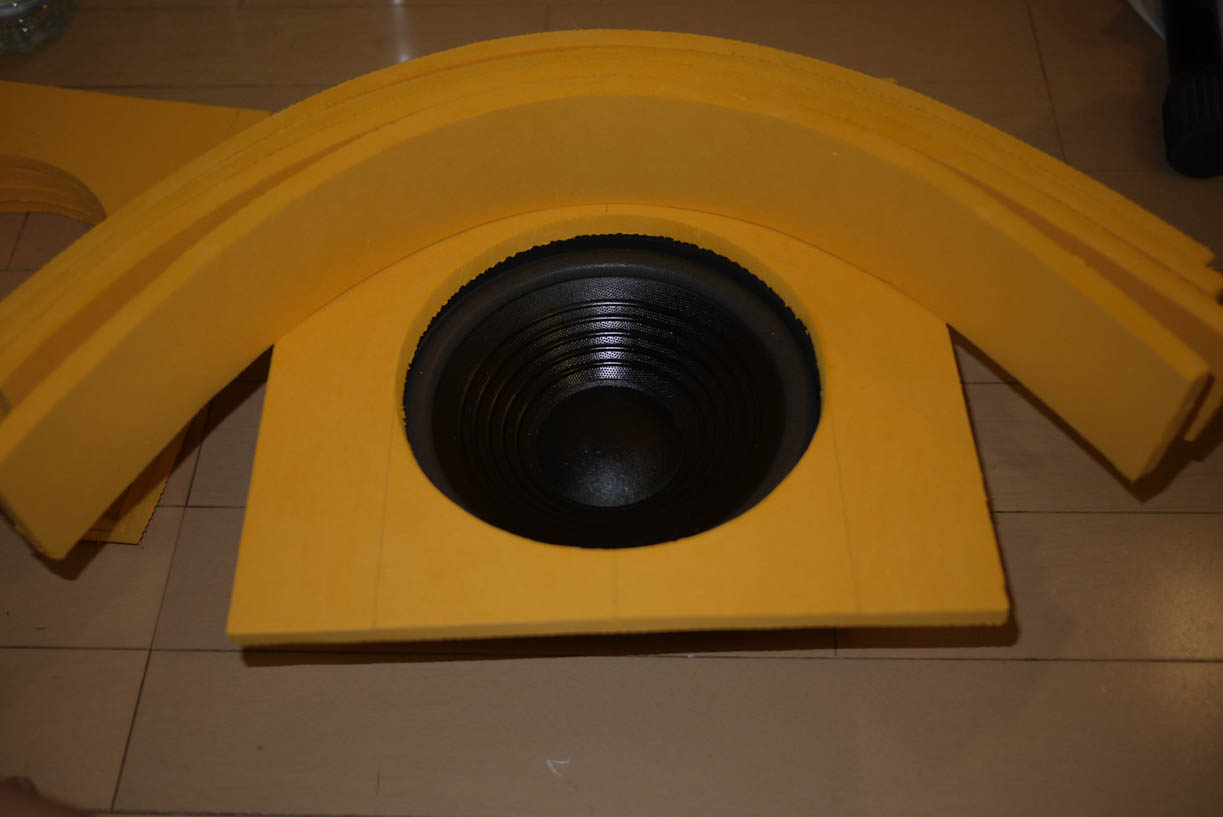
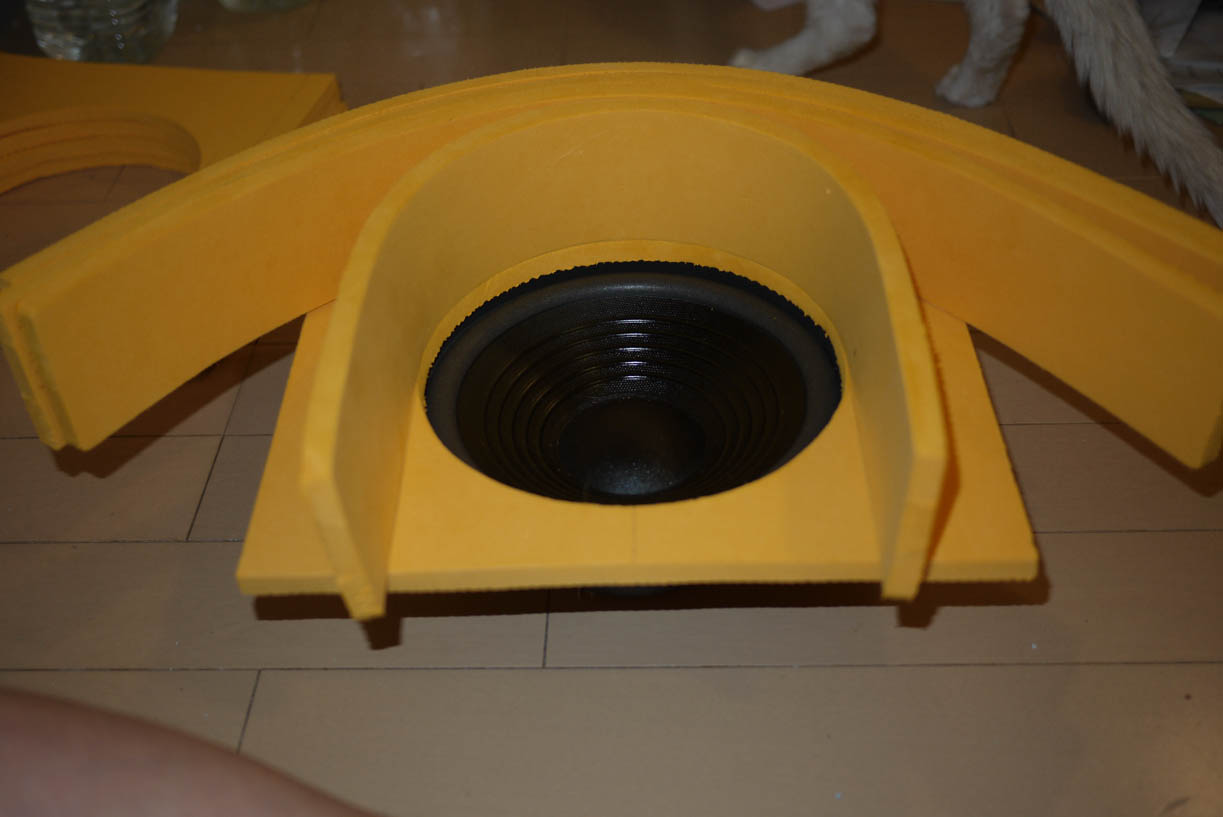
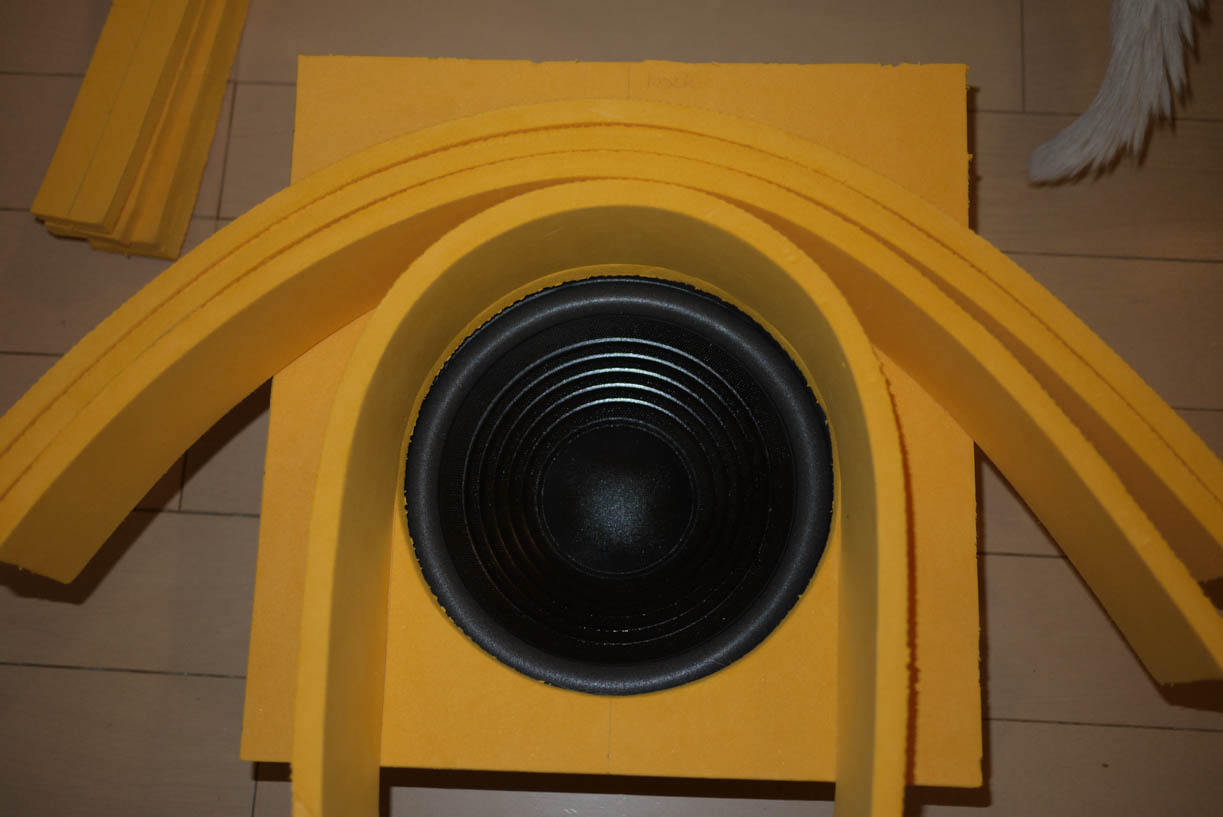
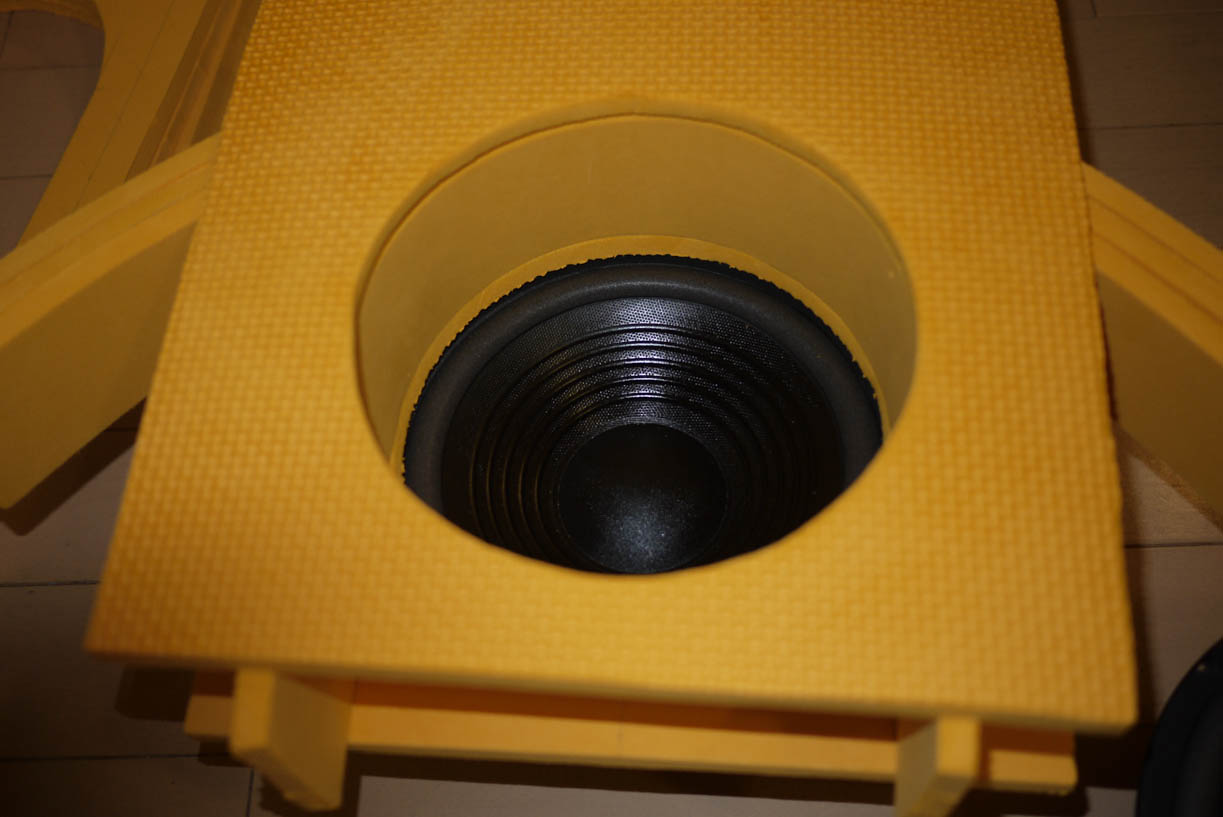
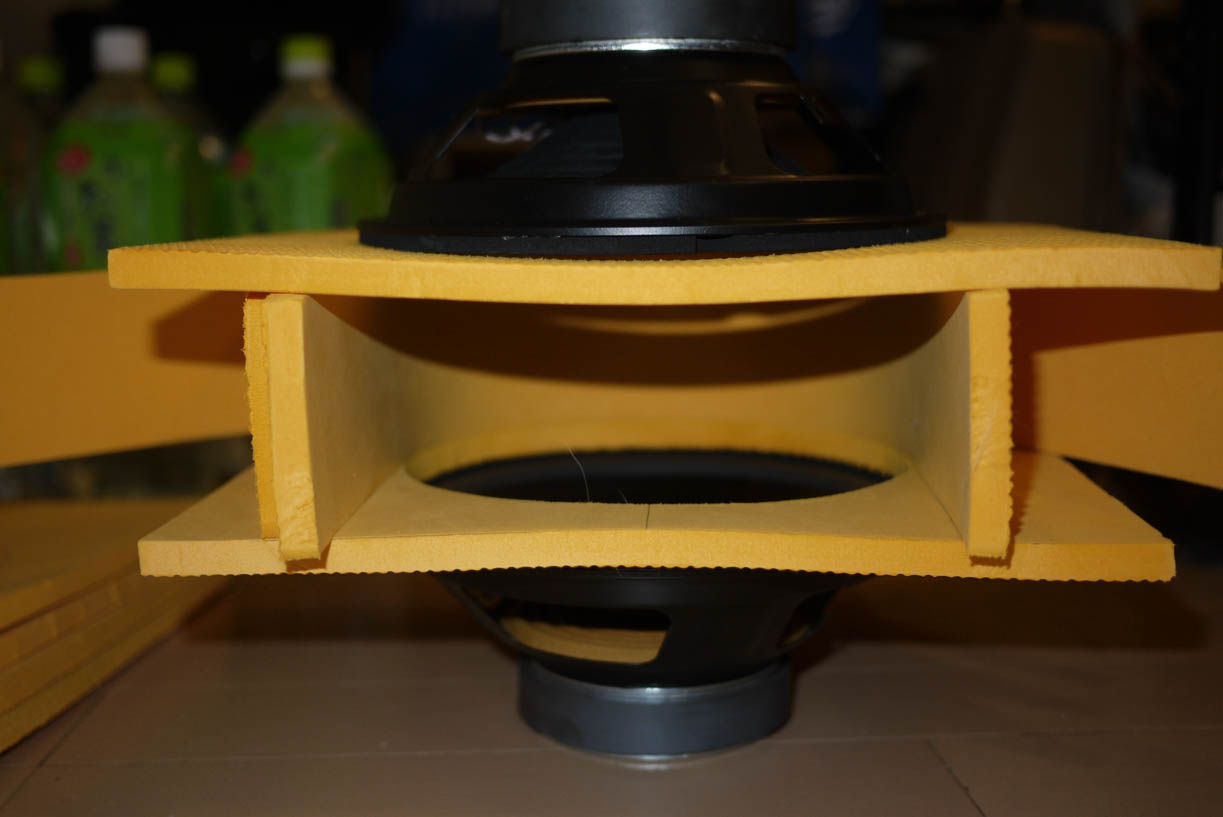
This structure will form a solid module (EVA slot plus 2x 8" drivers) which can be faced with several baffle shapes. With such a module, the front baffle and folded wings do not need to contribute to the structural rigidity of the speaker (absorb vibrations, nor hold the driver baffles rigid). The front and side baffles will only need to provide the baffle shape for controlling the destructive interference of the rear sound wave. Plus this module can also be oriented vertically or horizontally since it is a solid structure.
I started by following the nelson pass original design which cuts a curved slot shape into multiple layers of material (in his case MDF, in mine EVA) and laminate them to create the compression channel. But when I started building this way, I realized that it 1) wasted a lot of material that had to be cut away and 2) it created a very rough interior surface that would need to be sanded smooth. Since this channel is compressing the sound/air, I am thinking that the inner surface should be smooth to create as little turbulence as possible.

I then realized that I could take advantage of the ability of EVA to curve very easily. So I cut 4 strips, 70mm wide (my slot channel width) with the plan to laminate them to create a solid structure. I might be able to get away for 2x layers, but I plan to make 4x layers to make it very solid. Combine with panels top and bottom and then rear mounting the driver with threaded bolts going through the 90mm of solid EVA. For these pictures I pinned the inner strip to the rectangular piece. I may laminate another layer on each side, around the frame of the driver to give those rectangular pieces more rigidity, especially in the front which will be bolted up to the driver.






This structure will form a solid module (EVA slot plus 2x 8" drivers) which can be faced with several baffle shapes. With such a module, the front baffle and folded wings do not need to contribute to the structural rigidity of the speaker (absorb vibrations, nor hold the driver baffles rigid). The front and side baffles will only need to provide the baffle shape for controlling the destructive interference of the rear sound wave. Plus this module can also be oriented vertically or horizontally since it is a solid structure.
Attachments
Last edited:
one of the reasons I have been slow to glue this up, is that I am not sure I like this orange EVA/PE material. It has these nasty bumps on one side (non-slip floor tiles), and it is much lower density and softer than the white EVA (koyo soft board) that I normal use. Plus the label says it is PE foam (polyethelyene) and not EVA. But it feels and smells like EVA so I am not sure. But it was very cheap. I was able to cut all this orange from about 250¥ (~$2) worth of these orange EVA/PE floor tiles. If I would use my normal EVA it would cost about 1500¥ (~$12).
There is another EVA/PE floor tile I can get here which is covered in a thin layer of cork and does not have the bumps like this orange stuff. It only comes in 300mm x 300mm tiles but that should be enough for the top/bottom square and probably the front baffle and side. It is also very cheap and the cork may work well. I may pick a pack of that up and try it. If I don't like that, then I may just use my normal white EVA for the rectangular pieces, keep the orange curved strips. I need these rectangular pieces to be slightly rigid and to make a good seal with the drivers.
There is another EVA/PE floor tile I can get here which is covered in a thin layer of cork and does not have the bumps like this orange stuff. It only comes in 300mm x 300mm tiles but that should be enough for the top/bottom square and probably the front baffle and side. It is also very cheap and the cork may work well. I may pick a pack of that up and try it. If I don't like that, then I may just use my normal white EVA for the rectangular pieces, keep the orange curved strips. I need these rectangular pieces to be slightly rigid and to make a good seal with the drivers.
Interesting subject.
I agree that for near field use, constricted radiation pattern is a good thing.
I agree that a dipole / SLOB will give a forward lobe and restrict the radiation pattern.
All desirable.
But is OB near field going to throw the image too far? (a question, not mr criticising)
From what I recall (or think I recall), OB/SLOB 'projects' its image farther and for that reason I would've thought its impact would be lost.
Have you found this to be so?
I agree that for near field use, constricted radiation pattern is a good thing.
I agree that a dipole / SLOB will give a forward lobe and restrict the radiation pattern.
All desirable.
But is OB near field going to throw the image too far? (a question, not mr criticising)
From what I recall (or think I recall), OB/SLOB 'projects' its image farther and for that reason I would've thought its impact would be lost.
Have you found this to be so?
It's all on the back side so orange color won't be so visible. The final curve in the slot is visible to the front and make that one layer white. You could paint it all black and won't matter anyway? Looking good though. I was going to do same thing with curved foam core panels for the channel. Mine will be 6in about in diameter.
From what I recall (or think I recall), OB/SLOB 'projects' its image farther and for that reason I would've thought its impact would be lost.
Have you found this to be so?
My one OB/SLOB project was mono so not sure if I can say but I am not sure why image would be thrown farther away except for fact that there is a rear reflected image that adds ambience?
It's all on the back side so orange color won't be so visible. The final curve in the slot is visible to the front and make that one layer white. You could paint it all black and won't matter anyway? Looking good though. I was going to do same thing with curved foam core panels for the channel. Mine will be 6in about in diameter.
The orange color doesn't really bother me. It is more that the bumps make it hard to get a good seal with the drivers and make it hard to laminate layers. The bumps are also very difficult to sand off for some reason (maybe a coating on that side). Also this particular foam is lower density. These all just have me a little concerned, but it might not be so bad.
But maybe I just give another go at sanding the bumps around the driver hole so that I can get a nice seal, or maybe replace the front foam on the drivers with neoprene to help with the seal.
And you are right that I can always paint it black. But the orange color is not bad and it would be kind of cool to have the hint of orange showing on the inside of the slot
Compact faceplate tweeters from SEAS for reduced driver center-to-center distances and overall speaker dimensions (height).
Diaphragms are 27mm to help keep crossover frequencies low if desired.
H1396-04 27TFFNC/G
H1406-04 27TFFNC/CG
jonathan
PS. Jeshi, why not incorporate the URLs for your various speaker threads into your signature line?
Diaphragms are 27mm to help keep crossover frequencies low if desired.
H1396-04 27TFFNC/G
H1406-04 27TFFNC/CG
jonathan
PS. Jeshi, why not incorporate the URLs for your various speaker threads into your signature line?
Last edited:
ordered another DQ25 and TG9 today so now I can make a stereo pair. The little OB sounded really good and was very easy to build. This might end up being my first actual pair of matching DIY speakers. I will only build a single SLOB for now, but it should allow me to test the concept. At least the stereo pair of DQ25/TG9 small OB will allow me to really answer the imaging question mondogenerator asked.
But I did check imaging (sort of) by running the small OB on the right with my SB65-TL on the left with music I know has very good depth cuing on the right side. For this passage of music the left contributes maybe only 10% to the character of the sound, just enough to move it ~5deg in toward the center. Well this little OB produced an amazingly clear, refined image. Excellent outline and just the right amount of depth. And the depth did not detract from the clarity of hearing the instrument. The track I used for this is Lorrena McKennitt "Prologue" from her "The Book Of Secrets" album. It is my go-to imaging track to help with setting up and aligning speakers in a room.
The most amazing thing about this OB was that I could clearly hear a difference in changing the time-delay from 0.06msec to 0.04msec (just changing the time delay). At 0.04msec the image flattened, lost most of its 3D nature, and felt less clear. I actually did the entire time delay by ear, and then checked my favorites (0.06msec and 0.08msec) with measurements after the fact. I think this is a really good sign that this speaker is doing something very well.
But I did check imaging (sort of) by running the small OB on the right with my SB65-TL on the left with music I know has very good depth cuing on the right side. For this passage of music the left contributes maybe only 10% to the character of the sound, just enough to move it ~5deg in toward the center. Well this little OB produced an amazingly clear, refined image. Excellent outline and just the right amount of depth. And the depth did not detract from the clarity of hearing the instrument. The track I used for this is Lorrena McKennitt "Prologue" from her "The Book Of Secrets" album. It is my go-to imaging track to help with setting up and aligning speakers in a room.
The most amazing thing about this OB was that I could clearly hear a difference in changing the time-delay from 0.06msec to 0.04msec (just changing the time delay). At 0.04msec the image flattened, lost most of its 3D nature, and felt less clear. I actually did the entire time delay by ear, and then checked my favorites (0.06msec and 0.08msec) with measurements after the fact. I think this is a really good sign that this speaker is doing something very well.
My one OB/SLOB project was mono so not sure if I can say but I am not sure why image would be thrown farther away except for fact that there is a rear reflected image that adds ambience?
Nor am I, its just something I recall having been said by someone or other, over the years ive been here. Whether there's truth to it...well.I don't know.
Never been a fan of dipoles, too much room excitation (except in the LF)
But perhaps some image effect will be largely dependant on rear wall distance, except (I assume setup) with the opposite situation; I.e. Later reflections from the rear wall, as opposed to the normal situation in mid field I.e. Similar arrival times for rear reflection to reach listener, as front radiation refections from rear wall behind listener.
I just imagine that the stability of image, and its optimisation would be very finicky.
OB has its benefits, just they seems to be at odds with limitations.
I.e. Less excitation of room modes (below Schroeder?) massive benefit, drawback being less real bass extension (except in some cases...)
OB bass and monopole mids/HF ( that's just how id do it )
Lose the room modes in bass, and narrow DI for mids/HF to again remove as much room influence.
Isn't that what near field listening is all about? (at least if you're mastering)
Last edited:
I.e. Less excitation of room modes (below Schroeder?) massive benefit, drawback being less real bass extension (except in some cases...)
OB bass and monopole mids/HF ( that's just how id do it )
Lose the room modes in bass, and narrow DI for mids/HF to again remove as much room influence.
Isn't that what near field listening is all about? (at least if you're mastering)
I am looking at this mostly as an experiment. Almost all my other builds are sealed boxes. I just really want to see how an OB bass works in my room. I know my electrostatics work well in my room, so I was curious how a whole OB 3way nearfield would work. I just know that my room is small and I have side wall reflections which I have to treat with absorption panels. Also the place where my home studio speakers are set up, actually has about 2.5m of space behind them (so rear energy is less of a concern). They are setup basically in the middle of the room and fire down the long direction of my room. Maybe this design is really optimized for my room. I tried several ways to setup the room and this was the best (running along the long direction, treating the side walls for reflections and lots of space behind and in front of the speakers). Similar to what is recommended here RealTraps - How To Set Up a Room
But yes near field monitors should produce a flat frequency response and clarity to hear all the details and remove the room as much as possible (usually through acoustic treatment).
In the end it will come down to whether the reduction in side energy and wall reflections outweighs the increased rear energy. But at least by using a tweeter (and not a fullrange) the treble region will only project forward.
But so far the experiment is showing really good promise.
Last edited:
Probably a very relevant thread for us to look at:
http://www.diyaudio.com/forums/multi-way/225399-desktop-dipole-monitors.html

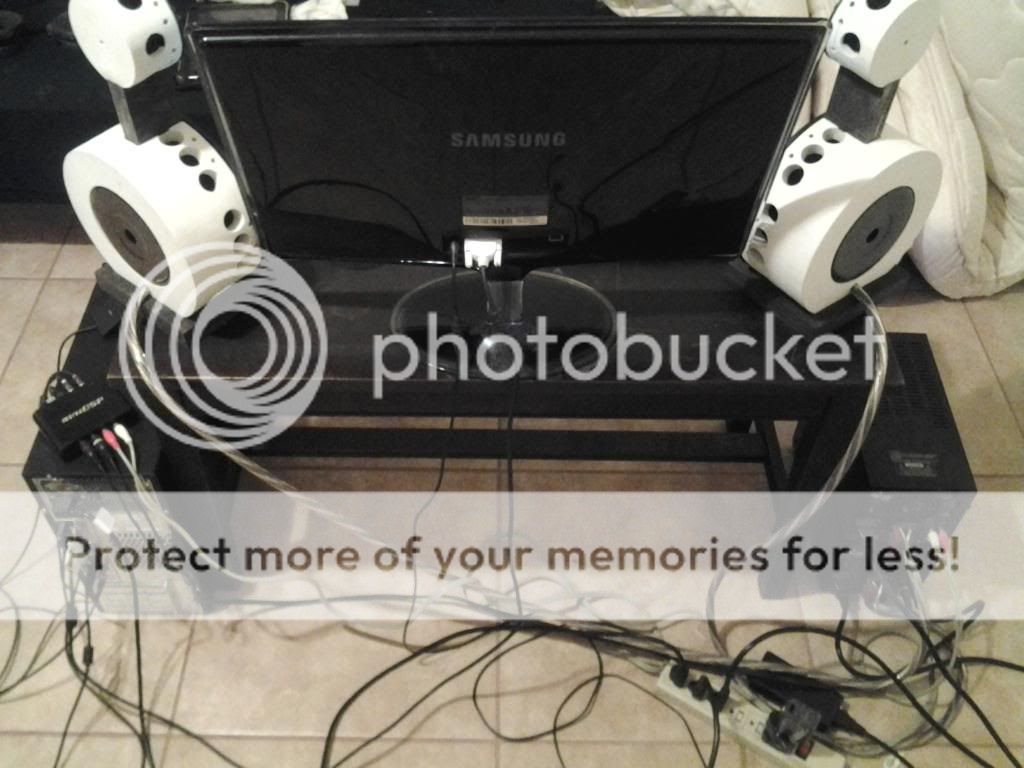
http://www.diyaudio.com/forums/multi-way/225399-desktop-dipole-monitors.html


it sounds like a cool experiment
I was just riffing. Its not a critique in any way, just my take, a beermat idea if you will. I cant say ive really I have spent a long time considering OB bass.
I too live in a small place. My living area comprises a lounge and kitchen, all partially open plan, broadly speaking L shaped 16-18ft by 13ft wide. Speakers set in each corner of the living space, 7ft apart, listening position 2/3rds back along one arm of the L. Right speaker in the corner of the L, left in the corner formed by partial partition into the kitchen area. To be more accurate, from my listening perspective I sit 8ft in front of the hifi, and the 'L' is orientated as a '7', seating level with the inside corner of the '7'.
So it probably breaks nearly all the rules But I have a small apartment, and not enough space for anything. Thus OB has never appealed, id end up giving up 1/3rd of the room for rear clearance.
But I have a small apartment, and not enough space for anything. Thus OB has never appealed, id end up giving up 1/3rd of the room for rear clearance.
I thought about Ripoles, and never built one, mainly as they get a very bad rep here (maybe elsewhere, but one forum.is enough for me)
Something like Visatons Grand Orgue would be interesting to listen to...
I was just riffing. Its not a critique in any way, just my take, a beermat idea if you will. I cant say ive really I have spent a long time considering OB bass.
I too live in a small place. My living area comprises a lounge and kitchen, all partially open plan, broadly speaking L shaped 16-18ft by 13ft wide. Speakers set in each corner of the living space, 7ft apart, listening position 2/3rds back along one arm of the L. Right speaker in the corner of the L, left in the corner formed by partial partition into the kitchen area. To be more accurate, from my listening perspective I sit 8ft in front of the hifi, and the 'L' is orientated as a '7', seating level with the inside corner of the '7'.
So it probably breaks nearly all the rules
I thought about Ripoles, and never built one, mainly as they get a very bad rep here (maybe elsewhere, but one forum.is enough for me)
Something like Visatons Grand Orgue would be interesting to listen to...
Probably a very relevant thread for us to look at:
http://www.diyaudio.com/forums/multi-way/225399-desktop-dipole-monitors.html


Baffles are tiny, no radius. Very high BSC requirement, plus awful passband diffraction ripple.
"correct that with DSP!"
Why would you do something the hard way? (or rather why correct what you needn't cause?)
Rear distance is nothing like sufficient. Guess that doesn't matter with backs on, or less so.
C-C distance is also needlessly large.
Weird loading though, for the bass. Not OB, SLOB. More like woefully undersized reflex, with very large port area. Tuned so high its always unloaded below Fb. Very odd.
Me personally.., if just go with a waveguided 2" and ripole/sealed bass. 2.1 even.
Tbh you guys/gals can do better
Last edited:
- Status
- This old topic is closed. If you want to reopen this topic, contact a moderator using the "Report Post" button.
- Home
- Loudspeakers
- Multi-Way
- OB compact 3way nearfield monitor
